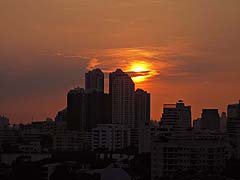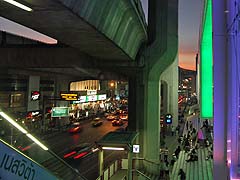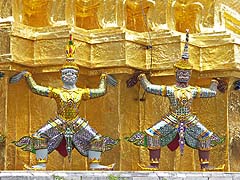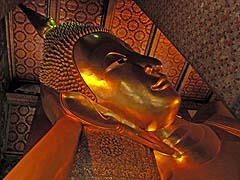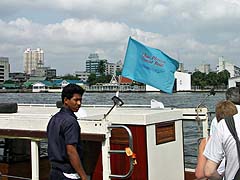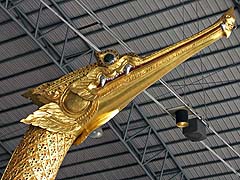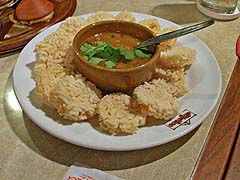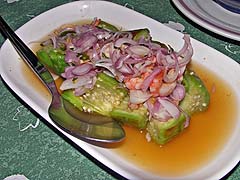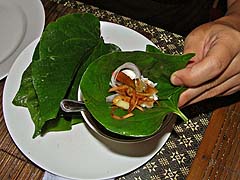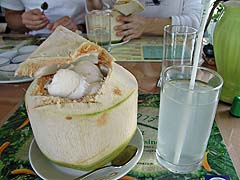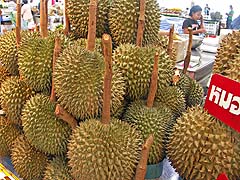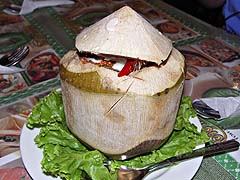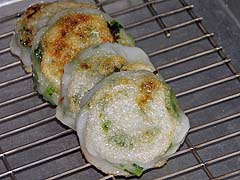City of Angels
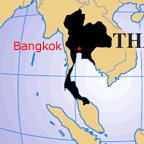 Bangkok is the capital of Thailand, and its
international crossroads. Hot, humid, smoggy and overcast even in the
"cool season," its chief attractions to South-bound travelers appear
to be its busy markets and high quality restaurants, and the
soon-to-be-missed ready availability of high-speed Internet access.
Bangkok is the capital of Thailand, and its
international crossroads. Hot, humid, smoggy and overcast even in the
"cool season," its chief attractions to South-bound travelers appear
to be its busy markets and high quality restaurants, and the
soon-to-be-missed ready availability of high-speed Internet access.
Travelers from California can choose to arrive in Bangkok in the middle of the night or in the afternoon. Having tried it both ways, the great benefit to emerging from the airport around 2:30 AM is very little traffic, and thus a speedy taxi ride to the hotel. But the gawking — at the skyline, the crowded sideways, at pretty much everything — is decidedly better in the light of day.
On my 2005 trip, I spent a couple days in Bangkok upon arrival in Thailand, and one and a half last frantic shopping days prior to departure. In 2006 I extended my stay to see a few more sights. Still, there is far more to see, smell, taste and feel than I was able to sample during my brief stay. I'm happy to relate a few highlights.
Accommodations
Bangkok hotels range from world renowned oases of luxury, on the one hand, to seedy dumps, on the other. We stayed at the Grand Tower Inn, a business-oriented hotel a short walk from a BTS Skytrain station on the Sukhumvit line at Soi Thonglor (Soi 55). At approximately $35/night, it provides a clean and comfortable room at a reasonable price. However, it is relatively far from the Grand Palace and other popular sites, so if time is tight, it might not be the best location. Also, the hotel caters more to Japanese-speaking patrons than to English speakers, so communications can be a bit rough if you don't know much Thai.
Accommodation Facts:
- Breakfast: complimentary buffet with an eclectic selection of Western, Thai and Japanese choices.
- Internet Access: business center; in-room wi-fi with the purchase of minutes at the front desk; inexpensive cybercafes available nearby on Soi Thonglor.
- Laundry Service: available.
- Smoking: there are no nonsmoking floors or nonsmoking rooms.
- Storage: because we were returning at the end of our trip, the hotel generous stored bags and boxes of purchases we didn't want to schlep around the country.
The hotel has driveways to both Sukhumvit and Soi Thonglor, and there are 7-11 stores located near each to satisfy your bottled water and ice cream bar needs. The nearest supermarket is a significant hike up Soi Thonglor.
To ease the aches and pains of air travel, you can drop in for a traditional two-hour Thai massage or a 90-minute foot massage at Hatthai on Sukhumvit, for less than $10 each. (I suggest wearing shorts for a foot massage, to avoid getting massage oil or lotion on the legs and cuffs of long pants.) If you are not familiar with traditional Thai massage, this is the routine at Hatthai. They start by washing your feet, giving you a pair of (often too small) slippers, and leading you upstairs to a room with several futon-style mattresses separated by curtains. Here you change into a pair of (often too small) lightweight pajamas and your masseuse begins work, moving methodically over two hours from the feet and legs to the back, neck, head and shoulders. In addition to fingers and palms, the Thai masseuse applies pressure using elbows, knees, and feet; one walked on my back. Now and then, I experienced unexpected pain, both from direct pressure and from stretches of muscles that I probably hadn't used for twenty years. During the first ten minutes, I thought there was no way I'd make it through two hours, but by the end, I was suprised that so much time had passed. There were some grimaces and grunts, and these sometimes drew a giggle. But mostly it was the serious business of trying to relax and get ready to hit the town.
Temples and Museums
The Grand Palace houses the temple of the Emerald Buddha, one of the most important and ornate stops in Bangkok. Located near the Chao Phraya river, the easiest way to reach the Grand Palace and nearby temples from the Grand Tower is to take the BTS Skytrain to the Saphan Taksin station where you can hook up with the river taxi. (If you are a risk taker and prefer a more direct route, a motorbike taxi might help you thread through the traffic.) Immediately next to the Central Pier (Sathorn or Thaksin) are several vendors selling bottled drinks and snacks. If you like charbroiled squid on a stick you will have numerous choices. My recommendation is the fried chicken with sticky rice. Deep fried in a wok and chopped before your eyes, it is as delicious as it smells.
The banks of the Chao Phraya are home to posh hotels and rickety hovels. The water itself is disturbingly brown and a bit foamy. One source might be the taxis themselves: they spit streams the color of squid ink into the river when they change direction. Fortunately, these boats were designed to avoid getting the passengers wet. Even so, some spray occasionally landed on exposed skin; I just tried not to get any too close to my mouth.
Once you arrive at the Grand Palace, you likely will be approached by friendly men volunteering to help you with your itinerary. They seem particularly attracted by maps. If at first they can't persuade you to accept their services, many will make up reasons that you won't be admitted to the Grand Palace, such as inappropriately short pants (don't worry, you can borrow long pants inside) or temporary closure for Buddhist ceremonies. You should ignore these touts and head inside. You should ignore them, but in 2005 one of my travel companions insisted that a spin around Bangkok in a couple of tuk-tuks to see four Buddhas for only twenty baht was too good a deal to turn down. As you might guess, it was not the whole story: there were to be some additional stops. After visiting an unbelievably tall statue, our drivers played the sympathy card, noting that they earned gas vouchers by taking tourists to jewelry stores. We obliged, peered politely into the shop's display cases while we took turns using its impeccably clean restroom. Then we demanded to return to the Grand Palace and after "Mr. Toad's wild ride" we arrived back not a moment too soon, ushered in just before the gates closed. It was, fortunately, a harmless diversion, but others have reported being subjected to a hard sell or even accusations of gem theft. For best results, just say "mai ow" to street touts.
It was difficult to appreciate the entire grounds in just an hour (had to return the pants I had borrowed), but we were assisted by one of the many men who hire themselves out to tourists as guides. With the gift shop closed, we thought we would head across the street to a bookstore for some postcards. The moment the light turned, as if on cue, at least a dozen young people (some small children, others teenagers or older) sprouted long strings of postcards from their hands and charged into the streets, swarming everyone. We made it into the shop unscathed, but on the way back we literally could not close the door of our taxi without buying a couple packs of cards. The traffic was awful, as expected, but we couldn't see walking to the Skytrain station in the heat.
Next door to the Grand Palace is Wat Pho, renowned for its school of Thai massage (I didn't try it) and its immense reclining Buddha (too large even to photograph). Across the river is Wat Arun, offering panoramic views from its steep-sided buildings. Just outside the Tha Tien pier is a vendor selling fresh squeezed tangerine juice, his cart made distinctive by an improvised tangerine tree. This and the strong air conditioning of a nearby "Internet and Games" place can help cool overexposed skin and refresh a weary traveler before proceeding on. Further up the river is the Royal Barges Museum, a quiet hangar-like space housing several ornately decorated boats used only for ceremonial processions. The museum charges a surcharge of 100 baht to take still photos; more for video. Without a strong flash gun, though, photo opportunities are limited.
Jim Thompson, an American who settled in Thailand, liked to collect art and popularized Thai silk when the industry was succumbing to competition from other fabrics. Today his "house," assembled from numerous teak houses he gathered from around the country, is a museum operated by a foundation. On my visit there, our tour guide had a great command of English, but our group was just a little too big for some of the rooms so we spilled out into the halls and occasionally had difficulty hearing the narration. Since the only air conditioning was in a separate special exhibit — or in the gift shop — those areas received disproportionate attention. Worth a stop for architecture fans, or those looking for particularly nice silk gifts, but for others there are more interesting distractions.
Shopping
Despite the emergence of fancy air conditioned shopping centers, traditional markets still thrive in Bangkok. The largest of these is the Chatuchak (also pronounced Jatujak) Weekend Market. Adjacent to the Mo Chit BTS Skytrain station, JJ market contains row after row of individual vendor stalls selling everything from hand-carved elephants to live puppies. The clutter is overwhelming, but fortunately most items are available from more than one seller because you could never get to all the stalls. In fact, you can hardly find your way back to one you saw hours before, so it is a good idea to "buy it when you see it" — assuming you can negotiate an acceptable price (unlike retail, everything is negotiable). As the crowds grow, choking the narrow walkways, the temperature inside the market becomes oppressive, so it is best to arrive at 8AM if you can. The "Beware of Pickpocket" signs posted everywhere are your reminder that some of the bumps and jostles might not be accidental.
Shopping can work up an appetite, and you will find snack vendors here and there in the maze of stalls. You can pick up steamed buns (dim sum) and head to the central "courtyard" area for some shade and open air, or you can try the enormous Toh-Plue Restaurant. Here we enjoyed a variety of dishes seldom seen in California, including a seafood curry served in a young coconut (remember to spoon out the tender coconut "meat"), and a fried catfish salad prepared by separating cooked catfish meat into small bits, frying them crunchy, and crumbling the featherweightflakes over shredded cabbage, dressed at the table with a light lime-chili dressing with shreds of green mango. Wow.
If you are departing Bangkok for Southern Thailand, some items you might purchase include: lightweight shirts; flip-flops for the beach (typically marked with European shoe sizes); zip-up fiberglas bags with convenient carry handles for miscellaneous hauling (note: these are not sufficiently water-tight to keep valuables dry on a longtail boat); and anything irresistable, because surely you won't want to try to find it here again!
While Chatuchak may offer the best deals, the atmosphere is more pleasant at the Suan Lum Night Bazaar, adjacent to Lumpini park (and just off the remarkably modern subway). Spared closure by its new owners in April 2007, this market is expected to close sometime in 2008 to make way for a new office complex. Until then you can pick up handicrafts, furniture, organic Thailand-grown tea, and salacious t-shirts in this relatively calmer, cleaner and trendier spot. Hungry? On one end, you will find individual vendor carts, and on the other, a centralized food court (centralized meaning you purchase tickets from a window that you use to pay at the individual stalls). During my visit, much of the food court seating area had been converted into a huge "beer garden" where "beer girls" promoted Heineken, Tiger, Chang, and many other brands I didn't recognize. Big screens showed the sporting event of the day: not Thai boxing, but Liverpool vs. Manchester United. During the half time break, bands performed on a stage under one of the screens. For dinner I had roast pork neck (a delicious fatty cut) with rice, and a hot green papaya salad. When the woman making the salad held up a tiny Thai chili pepper, as if to ask "do you want any?", I responded "phet mak mak" which roughly translates to "very very hot." She repeated this in an amused, slightly mocking voice "ohhhhh, phet mak mak" as she proceeded to toss in 2, 5, 8... I lost count. Good salad, and very good for beer sales.
To have the market experience inside a modern, air conditioned building, you might visit Mahboonkrong Center (better known as MBK Center), conveniently positioned at the end of the Sukhumvit BTS Skytrain line. Don't be surprised to find panhandlers along the walkways between MBK and nearby shopping centers, but Thai discussion boards discourage giving to these needy individuals because most are "employed" by an exploitive network that collects nearly all of the donations you give. Once inside, beyond the large Tokyu department store, you find a maze of shops and stalls. On the fourth floor, dubbed the "IT zone" and claimed to be the place for electronics, I found over 600 stalls dedicated just to mobile phones and related accessories. With everyone seeming to sell the same thing, most of the young women working the counters were doing their makeup rather than reaching out to potential customers.
Naturally, MBK has a food court (6th Floor) and it offers both the usual Thai favorites and dishes from a wide variety of other cuisines. It is a bit confusing when some booths take cash and others take tickets, but once you catch on to the system, you can find almost anything you like. Here, I especially liked the green papaya salad. There also is a small food area inside the Tokyu store where I took a break for a refreshing young coconut.
Also downtown, but focusing more on the tourist trade, we stopped in at Narai Phand (AKA Narayana Phand), a classy, department store-like shop selling a broad range of handicrafts, clothing, china, and jewelry. In the basement, and around the sides of the store, you find a "bazaar" of small vendor shops willing to bargain, so it makes sense to check around before committing your money. Among the fancier treasures, I found some impractical and irresistable gift items, including a large wood carving of a very contented pig lounging on his back, and a bizarre $3 tie featuring what at first appear to be ghosts with various faces and accessories, but which, on closer inspection, turn out to be condoms.
Nearer the Grand Tower, Soi Thonglor has become a destination for the hip, trend-loving youth of Bangkok. (Reference: To Be Young and Hip in Bangkok, The New York Times, Nov. 20, 2005, travel section.) On a hot Winter evening I walked from Sukhumvit to the canal (about a mile and a half), where a seedy club marks the end of the wedding stores and chic coffee shops. On the way back I stopped at playground!, a three story boutique of trendy clothes, furniture, and toys, fashioned around play spaces. There were some swings suspended from the ceiling, and in keeping with a Love theme around Valentine's Day, there was a giant mouse in a wedding dress out front, brightly lit with soft pink spotlights. Interesting place, but I suspect not a good value.
A couple blocks later on the opposite side I found J Avenue; the "J" might refer to Japan or Japanese, but it's just a guess. Anchored by a Japanese supermarket (with sashimi assortments at about half the price of our local Nijiya market in Mountain View), and featuring several Japanese restaurants, this little mall features numerous hangouts for the younger set, such as Au Bon Pain, a dessert joint next door, and Greyhound Cafe. Three little tents showed off custom Mini Coopers. I definitely stuck out here: khaki dockers, not designer jeans; mustard colored batik shirt rather than a trendy black knit top or t-shirt; no cell phone; no posse. I'll just chalk it up to market research.
Good Eats
The area around the Grand Tower boasts several excellent restaurants, as well as smaller shops, street vendors, and an active night market. Just up Soi Thonglor is Thon Krueng, a festively lit restaurant with numerous rooms for private parties and a pleasant courtyard. Highlights included a deep-fried "cottonfish" (a kind of trevally) in a panko-like batter topped with shred of green mango a light sour-sweet sauce similar to a salad dressing; a spicy fish curry mousse served as individual steamed cakes on the ceramic plate on which it was steamed, each portion hidden in a well under a little ceramic cover; morning glories, sometimes known in California as Thai water spinach, sauteed with garlic; an appetizer of mini-rice cakes with a delicious chunky peanut sauce; and a roasted or fried duck, more crispy skin than flesh. Soups here featured delicious broths, but the beef and beef tendons seemed a bit worse for the experience. The super-sweet "Singapore style" dessert of green noodles (colored/flavored with Pandanus leaf extract) in a glass of shaved ice, coconut milk and syrup, served with a fat straw seems designed to appeal to the teenage set.
Crossing over busy Sukhumvit Road (using the elevated walkways for safety), it was just a few blocks to My Choice restaurant, where you may have your choice of chilly air conditioning indoors or a pleasantly warm patio seat outdoors. Despite the English-language name, the staff spoke little English, so we were fortunate to have an experienced hand ordering in Thai. As an appetizer, we shared a plate of Southern style crudités — green beans, slices of cucumber and young turmeric, and a banana blossom — with a rich crab meat and coconut dip. Numerous variations on this spicy theme are offered throughout Southern Thailand. Our salad introduced us to wing beans: long, flat pea-like pods cut crossways, tossed with shrimp, and sprinked with toasted shallots (and, perhaps, coconut shreds). Deliciously refreshing. A salad of tender roasted or smoked eggplants was even better. Main courses included a large plate of very dark green, spinach-like greens concealing pieces of mildly spiced roast duck; a wickedly spicy Southern curry with chicken and mixed vegetables (including baby corn that tastes like fresh corn!); and a specially pre-ordered masamum curry of beef tongue, smooth and rich, accompanied by roti (fried layered bread) for dipping. Dessert was a tight fit, but a coconut ice cream with basil seeds, which swelled to resemble tapioca beads, helped to cool the palate.
A bit further down the same street is Vientiane Kitchen, where the food and live entertainment are more Northeastern/Laotian in character. On a sultry evening, our table near the stage was frequently sprinkled with mist sprayed down from a high tower and blown to all corners of the restaurant by fans. Bad news for photographers: flash photos look as though they were taken in a snow storm. The beer girls in short skirts were another distraction. But I digress: you want to know about the food.
We started with miang plah, a fried fish dish eaten in a unique way. You take a large green leaf and fold in part of the edge so it forms a little cup. Then you add a small amount of fish and each of several condiments: cloves of garlic, peanuts, a pinch of toasted coconut, pieces of ginger, lime, lemongrass and shallots, and, optionally, hot little Thai chillies. Then you eat the leaf as a gently closed packet (not rolled like a taco, although no one would object if you ate it that way). Compared with a rather mild salad of beef slices, a salad of toasted (but not puffed) rice with tasty bits of Northeastern sour sausage, shallots, peanuts and other stuff was plush, rich, and novel. I thought the fried fermented fish (good in small quantities) was similar in aroma and taste to aged European cheeses, but no one around me shared my opinion on that. Another fish, steamed with (preserved?) bamboo shoots in a banana leaf reminded me of Hawaiian lau lau. The biggest hit was the deep fried crunchy pork legs, decadently moist (fatty) and crispy, with Flintstones-style big bones.
Throughout the evening, Thai dancers performed in different parts of the restaurant to the accompaniment of a live band. At one point, there was an audience participation segment with sword fighting and faux Thai boxing. Sitting by the stage has its detractions: a collision nearby tipped my water glass into my backpack. Once tranquility returned,I tried a confection of sweet black sesame paste, inside a mochi-like sticky rice ball, served in piping hot ginger tea (or soup, not sure of the translation). These components were not especially nice by themselves, but combining the chewy stick rice with the sweet sesame and the spicy ginger made for an excellent taste sensation.
At daybreak, particularly on Saturday mornings, the sidewalk between Sukhumvit Soi 55 and Soi 57 comes alive as vendors set up along storefronts and in the street. Fruit and flowers; raw fish and charbroiled meats; seared dumplings overstuffed with chives accompanied by a sweet soy dipping sauce and salty-sweet little khanom krok coconut pancakes (some with corn kernels); mysterious sweets in elaborate wrappers; if you don't mind the thick crowds, you can build a good breakfast and stock up for travel. Come on down before 9:00 AM for the best selection, and slightly cooler weather.
In the outer neighborhoods of Bangkok, toward the "old" Don Muang airport, we enjoyed lunch in a placid dining room at A. Mallika. We started with perfectly formed khanom krok, and crunchy sweet mee krob noodles in an edible basket made from taro shreds. A miang plah-style salad of thinly sliced mackeral was presented with lettuce for wrapping and flavor enhancers like cilantro, mint, diced ginger and lime, onions and peanuts. We scorched our palates with a fiery stir fry of beefy ostrich slices; tiny bits of deep fried fish which had completely absorbed a red curry sauce; and a soup with shrimp and sour greens. After this, a crispy roast duck served with thin crunchy noodles and a sweet dipping sauce was a relief (in truth, it was hard to taste anything, but the texture was excellent).
We finished with dessert. The house-made coconut sorbet was excellent, and even more impressive in a double-portion served inside a young coconut with the coconut water on the side. A small dish of coconut pudding completed the meal.
Partially over our jet lag, having started our adjustment to the hot weather and even hotter food, loaded with purchases and provision, we headed out of town in the darkness before dawn. Our next destination was Ranong, about 550 kilometers away.

